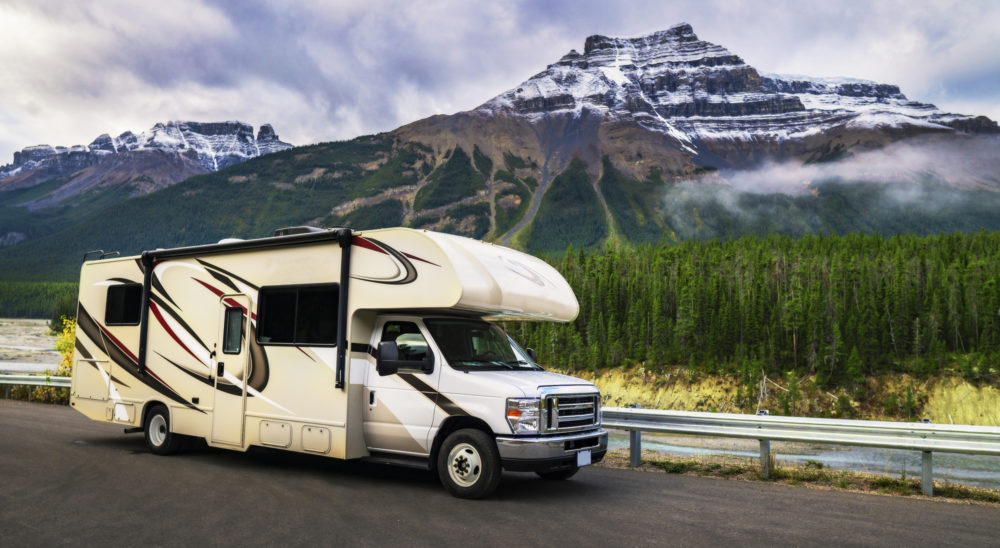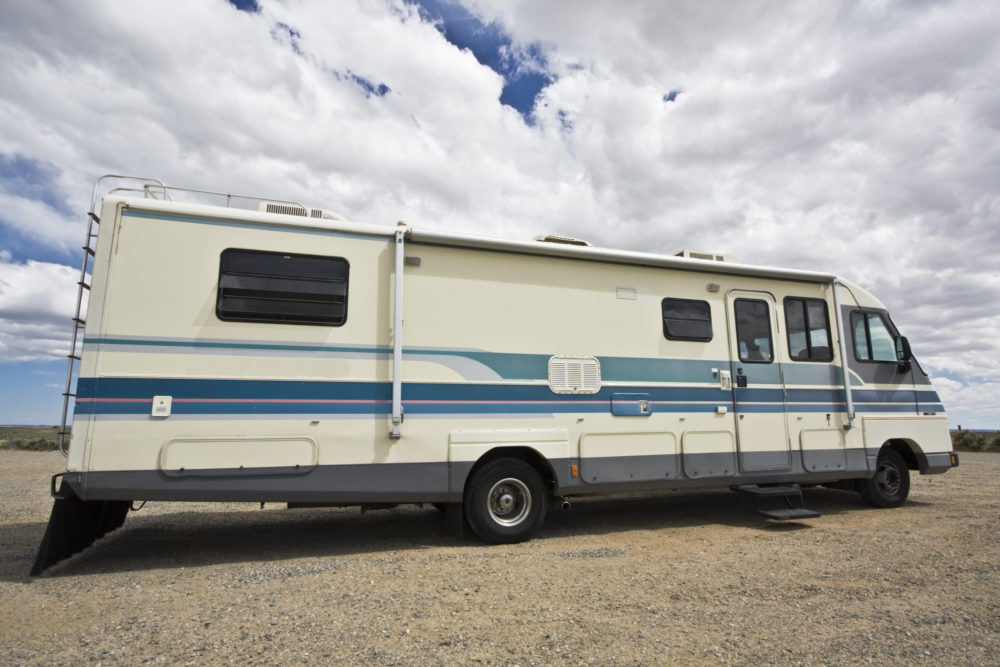How Tall and Wide Is An RV?
RV dimensions vary greatly on the type of RV, as well as the brand and layout/model choice. You can purchase RVs as short as 6 ft or as long as 45 ft. The width also varies, but not the variation is not as extreme as the lengths, largely due to the fact that there are traveling/road restrictions on maximum vehicle width in order to travel on the roads.
The width ranges from 4-10 ft (without the slideouts). The width is also largely regulated by each state and limited by the overpass or bridge clearance: the max height of an RV is 13’6”, and that includes the AC unit.

Contents
The smallest RV is a 6-ft teardrop trailer. Some brands like Scamp (www.scamptrailers.com) specialize in smaller RVs, but at 13 feet, these campers are still twice the length of the shortest teardrop trailer (cedarridgecampers.com).
The largest RV is a Class A, such as the Tiffin Allegro, with max length at 45 ft: tiffinmotorhomes.com.
Why Understanding The Dimension Of Your RV Is Important?
When you purchase your RV, you need to know the overall dimensions of your RV so that you know which roads you can travel on and you don’t end up getting stuck somewhere or damage your RV by going under a bridge that is not tall enough. There are apps and RV-specific GPS devices that you set up by entering your RV dimensions to get the routes that are accessible by your RV.
How To Measure An RV?
According to the Recreational Vehicle Industry Association (RVIA), the advertised length should be the floor plan length. However, there are three different measurements to look at when purchasing an RV and measuring the length and width:
“the interior, exterior, and overall length.
- The interior length of a trailer is how much living space the trailer has, which is one of the easiest measurements to get. It’s simply the length from the front wall to the back wall inside the trailer.
- The exterior length should be measured without the trailer tongue.
- The overall length is the length of the entire trailer. You should know the length of the trailer without the hitch and with the hitch and tow vehicle. The second measurement will be useful when choosing a parking spot or a campsite. “
(Source: trailandsummit.com.)
To measure the height, “[t]here are two and sometimes three camper heights you’ll need to worry about.
- The first height you’ll want to consider is the interior height of the camper. Find this height by measuring inside from floor to ceiling. Just be careful as some campers will have different height measurements inside of the camper.
For example, a fifth wheel camper will have more headroom in the living area than in the area overtop of your truck’s bed. - You’ll also need to take a couple of outside measurements. The main exterior measurement to be aware of is the height of the camper including any ceiling mounted air conditioning units.
- The next outside measurement you may want to take is the exterior height without the rooftop mounted air conditioning units.” (Source: www.godownsize.com)
To measure the width, measure wall-to-wall width at the widest spor on the camper (sometimes, the campers are wider in the mid-section).
Dimensions Of Different RV Class Types
There are many different types of RV trailers and each have different preferred use and max dimensions:
Travel Trailer
This RV is great for anyone who has a towing vehicle; often, you don’t need a ¾-ton or a 1-ton truck. These trailers are fairly affordable and are great entry-level trailers for families. They are somewhat easy to use and to hitch on. Some people full-time in travel trailers, as well.
The average length is 12 to 35 feet long.
The average width is 8 feet 6 inches.
The average height is between 10 to 12 feet.
The average weight is approx. 6,500 lbs.
Lightweight Trailer
This RV is great for anyone who has a towing vehicle, but not a ¾-ton or a 1-ton truck. These trailers are fairly affordable and are great entry-level trailers for families.
The average length is 12 to 35 feet long.
The average width is 8 feet 6 inches.
The average height is between 10 to 12 feet.
The average weight is anywhere from 3,500 lbs to 6,500 lbs.
Popup Camper
This RV is great for anyone who does not have a heavy-duty truck for pulling a trailer. It is also a great small camper that is easy to store. It is a good fit for singles, couples or even small families.
The average length is anywhere from 8 to 30 feet.
The average width is anywhere from 7 feet to 7 feet 6 inches.
The average height is between 4 feet 6 inches to 5 feet when closed.
The average weight is 2,000 lbs.
Fifth Wheel
This RV is great for anyone who loves the luxury and the feel of a home and enjoys having added stability when towing. Many full-timers choose a fifth wheel option due to the space, living-friendly layouts, as well as a good balance between affordability and comfort. It’s also a good fit for larger families, as many fifth wheels can accommodate anywhere from 8-12 people.
The average length is anywhere between 25-45 feet.
The average width is between 8 feet and 8.5 feet.
The average height is 13 feet-making it feel like a true home with nice high ceilings inside.
The average weight is anywhere from 12,700-16,000 lbs.
Toy Hauler
This RV is great for anyone who loves the layout and space of a fifth wheel RV, but also wants the space in the back of the trailer to haul four-wheelers, golf carts or to have that extra space as a patio or a converted office or even a workout room. Toy haulers are more expensive than many fifth-wheels and are often heavier (because they are longer). Many also include a second bathroom in the back.
The average length is anywhere from 40-45 feet, which is the max length. The garage section adds 10-12 feet to the trailer portion.
The average width is the standard 8.5 feet.
The average height is the maximum allowable height of 13.5 feet.
The average weight is about 10,000 lbs, leaving room for heavier cargo.
Class A Motorhome
This RV is great for anyone who replaces their home with an RV, since it’s basically a home on wheels. Many are high-end luxury models that can cost over $200,000.
The average dimensions for Class A are listed in the section below.

Class B Campervan
This RV is a blend of Class A and Class C and it is a good fit for couples or small families. It is more affordable and more manageable than a Class A, but also smaller than Class C. “Class C Motorhomes are built on a truck or van chassis with an attached cab section, while Class Bs are built within the dimensions of a customized van. Essentially, this means that Class Bs are more expensive to make.” (Source: blog.campersinn.com.)
The average dimensions for Class B are listed in the section below.
Class C Motorhome
This RV is great for singles or couples who do not need much space and are looking for comfortable ways to travel. A Class C is nimble in maneuvering, yet includes all the main amenities that make RVing comfortable (a nice bed, electricity, a kitchen and a bath).
The average dimensions for Class C are listed in the section below.
Class A RV Dimensions
Below are the dimension ranges for a Class A RV:
Width: 8-10 ft, average 9 ft
Height: 13-13”6” ft
Length: 29-45 ft
Class B RV Dimensions
Below are the dimension ranges for a Class B RV:
Width: 8-9 ft, average 8 ft
Height: 9-11 ft, average 9 ft
Length: 17-23 ft
Class C RV Dimensions
Below are the dimension ranges for a Class C RV:
Width: 8-9 ft, average 8’6” ft
Height: 10-12 ft, average 10 ft
Length: 22-44 ft, average 28 ft
FAQs
How wide is an RV with slides out?
With the average width of 8 feet and 2-3 feet per slide on one side, the overall width can be anywhere between 12-14 feet wide.
How tall is a travel trailer?
Travel trailers range from 10 to 12 feet in height, while Class A’s can max out at 13’ 6”.
How tall of a garage door do you need for an RV?
The garage door must be at least 12-16 feet tall, but to be on the safe side, one should go with 16 ft, if possible. (Source: www.4feldco.com.)
Does RV height include air conditioner?
The RV height does not usually include the AC (unless specified by the manufacturer), because the AC height can vary by brand and can change overtime due to warping/debris etc. (www.cruiseamerica.com)
Does RV length include tongue?
No, the RV length does not include the RV tongue (trailandsummit.com.).
Does RV length include tow vehicle?
No, the RV length does not include the tow vehicle (trailandsummit.com.).




